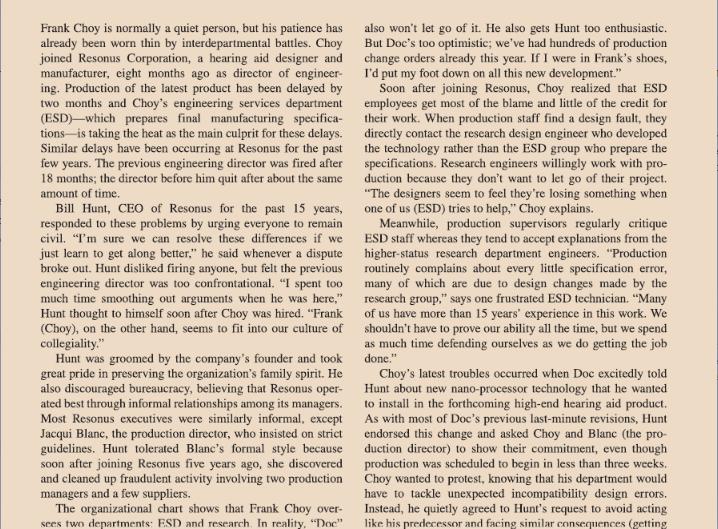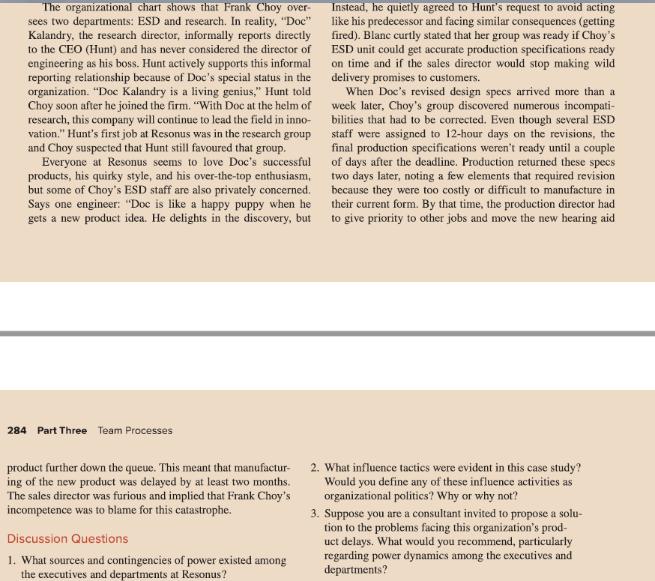Answered step by step
Verified Expert Solution
Question
1 Approved Answer
Frank Choy is normally a quiet person, but his patience has already been worn thin by interdepartmental battles. Choy joined Resonus Corporation, a hearing


Frank Choy is normally a quiet person, but his patience has already been worn thin by interdepartmental battles. Choy joined Resonus Corporation, a hearing aid designer and manufacturer, eight months ago as director of engineer- ing. Production of the latest product has been delayed by two months and Choy's engineering services department (ESD) which prepares final manufacturing specifica- tions is taking the heat as the main culprit for these delays. Similar delays have been occurring at Resonus for the past few years. The previous engineering director was fired after 18 months; the director before him quit after about the same amount of time. Bill Hunt, CEO of Resonus for the past 15 years, responded to these problems by urging everyone to remain civil. "I'm sure we can resolve these differences if we just learn to get along better," he said whenever a dispute broke out. Hunt disliked firing anyone, but felt the previous engineering director was too confrontational. "I spent too much time smoothing out arguments when he was here," Hunt thought to himself soon after Choy was hired. "Frank (Choy), on the other hand, seems to fit into our culture of collegiality." Hunt was groomed by the company's founder and took great pride in preserving the organization's family spirit. He also discouraged bureaucracy, believing that Resonus oper- ated best through informal relationships among its managers. Most Resonus executives were similarly informal, except Jacqui Blanc, the production director, who insisted on strict guidelines. Hunt tolerated Blanc's formal style because soon after joining Resonus five years ago, she discovered and cleaned up fraudulent activity involving two production managers and a few suppliers. The organizational chart shows that Frank Choy over- sees two departments: ESD and research. In reality, "Doc" also won't let go of it. He also gets Hunt too enthusiastic. But Doc's too optimistic; we've had hundreds of production change orders already this year. If I were in Frank's shoes, I'd put my foot down on all this new development." Soon after joining Resonus, Choy realized that ESD employees get most of the blame and little of the credit for their work. When production staff find a design fault, they directly contact the research design engineer who developed the technology rather than the ESD group who prepare the specifications. Research engineers willingly work with pro- duction because they don't want to let go of their project. "The designers seem to feel they're losing something when one of us (ESD) tries to help," Choy explains. Meanwhile, production supervisors regularly critique ESD staff whereas they tend to accept explanations from the higher-status research department engineers. "Production routinely complains about every little specification error, many of which are due to design changes made by the research group," says one frustrated ESD technician. "Many of us have more than 15 years' experience in this work. We shouldn't have to prove our ability all the time, but we spend as much time defending ourselves as we do getting the job done." Choy's latest troubles occurred when Doc excitedly told Hunt about new nano-processor technology that he wanted to install in the forthcoming high-end hearing aid product. As with most of Doc's previous last-minute revisions, Hunt endorsed this change and asked Choy and Blanc (the pro- duction director) to show their commitment, even though production was scheduled to begin in less than three weeks.. Choy wanted to protest, knowing that his department would have to tackle unexpected incompatibility design errors. Instead, he quietly agreed to Hunt's request to avoid acting like his predecessor and facing similar consequences (getting The organizational chart shows that Frank Choy over- sees two departments: ESD and research. In reality. "Doc" Kalandry, the research director, informally reports directly to the CEO (Hunt) and has never considered the director of engineering as his boss. Hunt actively supports this informal reporting relationship because of Doc's special status in the organization. "Doc Kalandry is a living genius," Hunt told Choy soon after he joined the firm. "With Doc at the helm of research, this company will continue to lead the field in inno- vation." Hunt's first job at Resonus was in the research group and Choy suspected that Hunt still favoured that group. Everyone at Resonus seems to love Doc's successful products, his quirky style, and his over-the-top enthusiasm, but some of Choy's ESD staff are also privately concerned. Says one engineer: "Doc is like a happy puppy when he gets a new product idea. He delights in the discovery, but Instead, he quietly agreed to Hunt's request to avoid acting like his predecessor and facing similar consequences (getting fired). Blanc curtly stated that her group was ready if Choy's ESD unit could get accurate production specifications ready on time and if the sales director would stop making wild delivery promises to customers. When Doc's revised design specs arrived more than a week later, Choy's group discovered numerous incompati- bilities that had to be corrected. Even though several ESD staff were assigned to 12-hour days on the revisions, the final production specifications weren't ready until a couple of days after the deadline. Production returned these specs two days later, noting a few elements that required revision because they were too costly or difficult to manufacture in their current form. By that time, the production director had to give priority to other jobs and move the new hearing aid 284 Part Three Team Processes product further down the queue. This meant that manufactur- ing of the new product was delayed by at least two months. The sales director was furious and implied that Frank Choy's incompetence was to blame for this catastrophe. Discussion Questions 1. What sources and contingencies of power existed among the executives and departments at Resonus? 2. What influence tactics were evident in this case study? Would you define any of these influence activities as organizational politics? Why or why not? 3. Suppose you are a consultant invited to propose a solu- tion to the problems facing this organization's prod- uct delays. What would you recommend, particularly regarding power dynamics among the executives and departments?
Step by Step Solution
There are 3 Steps involved in it
Step: 1
1 What sources and contingencies of power existed among the executives and departments at Resonus Power at Resonus appears to stem from multiple sourc...
Get Instant Access to Expert-Tailored Solutions
See step-by-step solutions with expert insights and AI powered tools for academic success
Step: 2

Step: 3

Ace Your Homework with AI
Get the answers you need in no time with our AI-driven, step-by-step assistance
Get Started


